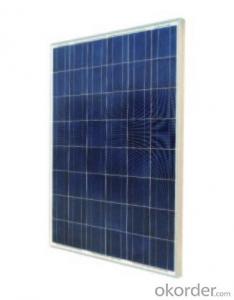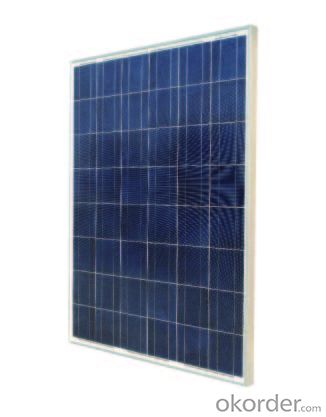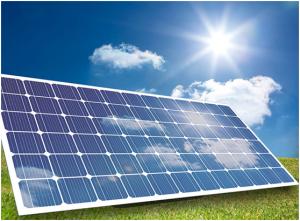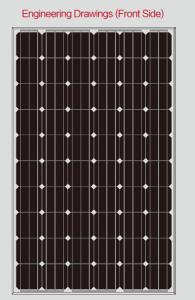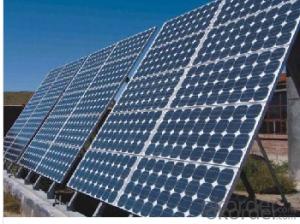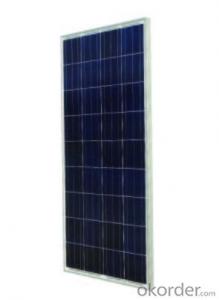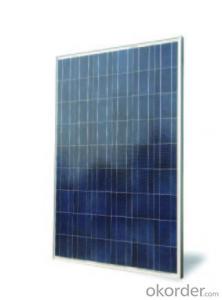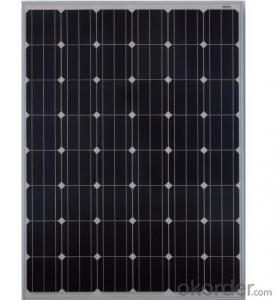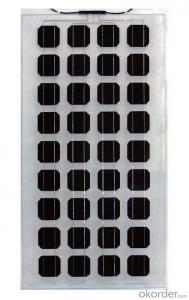Mono Versus Poly Solar Panels - Poly Crystalline Solar Panel RS195(P)-48
- Loading Port:
- China main port
- Payment Terms:
- TT OR LC
- Min Order Qty:
- 2000 watt
- Supply Capability:
- 1000000 watt/month
OKorder Service Pledge
OKorder Financial Service
You Might Also Like
Quality Assurance
10 Years Material & Craft
Power Guarantee
12 Years 90% Output
25 Years 80% Output
ISO9001:BSI
ISO14001:BSI
OHSAS18001:BSI
High Module Efficiency
Mechanical Load Capability up to 8000 Pa
Salt Mist Corrosion Protect Ammonia Resistance
Potential Induced Degradation Free
RS195P-48
RS185P-48
RS190P-48
RS200P-48
RS205P-48
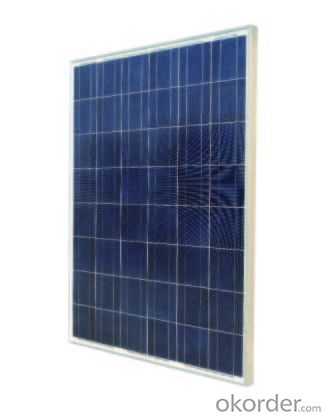
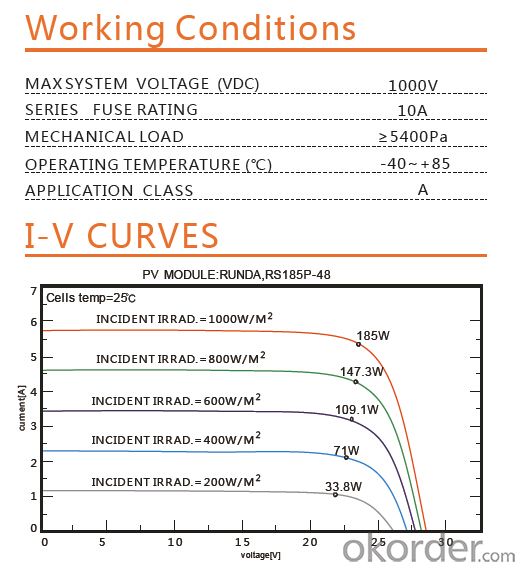
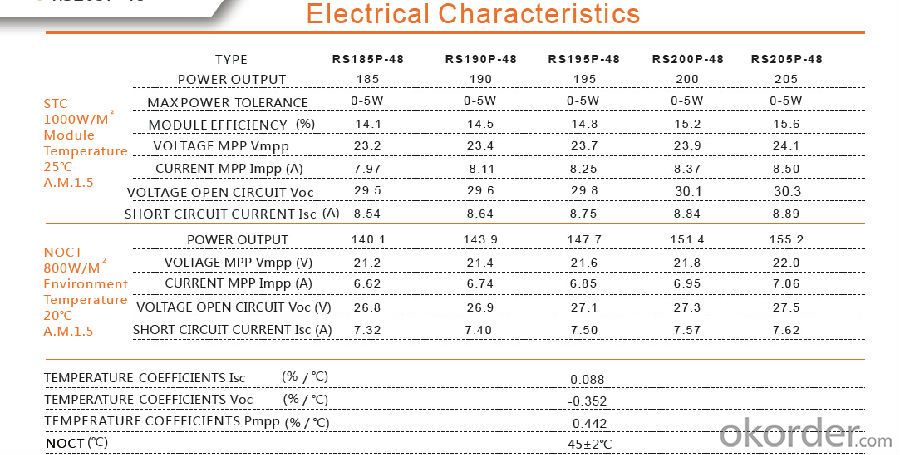
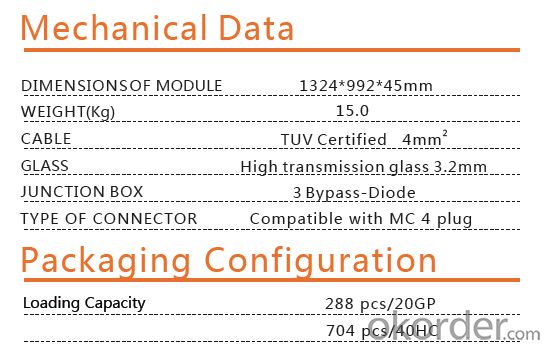
Structure of Solar Panels Description
Solar panel refers either to a photovoltaics (PV) panel, a solar hot water panel, or to a set of solar photovoltaics panels electrically connected and mounted on a supporting structure. A PV panel is a packaged, connected assembly of solar cells. Solar panels can be used as a component of a larger photovoltaic system to generate and supply electricity in commercial and residential applications. Each panel is rated by its DC output power under standard test conditions, and typically ranges from 100 to 320 watts. The efficiency of a panel determines the area of a panel given the same rated output – an 8% efficient 230 watt panel will have twice the area of a 16% efficient 230 watt panel. There are a few solar panels available that are exceeding 19% efficiency. A single solar panel can produce only a limited amount of power; most installations contain multiple panels. A photovoltaic system typically includes a panel or an array of solar panels, an inverter, and sometimes a battery and/or solar tracker and interconnection wiring.
Efficiencies
Depending on construction, photovoltaic modules can produce electricity from a range of frequencies of light, but usually cannot cover the entire solar range (specifically, ultraviolet, infrared and low or diffused light). Hence, much of the incident sunlight energy is wasted by solar modules, and they can give far higher efficiencies if illuminated with monochromatic light. Therefore, another design concept is to split the light into different wavelength ranges and direct the beams onto different cells tuned to those ranges. This has been projected to be capable of raising efficiency by 50%. Scientists from Spectrolab, a subsidiary of Boeing, have reported development of multijunction solar cells with an efficiency of more than 40%, a new world record for solar photovoltaic cells. The Spectrolab scientists also predict that concentrator solar cells could achieve efficiencies of more than 45% or even 50% in the future, with theoretical efficiencies being about 58% in cells with more than three junctions.
FAQ of Solar Panels
Q1:Can we visit your factory?
A1:Sure,welcome at any time,seeing is believing.
Q2:Which payment terms can you accept?
A2:T/T,L/C,Moneygram,Paypal are available for us.
Q3:How to guarantee the Quality of the products?
A3:We have established the international advanced Quality management system,every link from raw material to final product we have strict Quality test;We resolutely put an end to unQualified products flowing into the market. At the same time, we will provide necessary follow-up service assurance.
- Q: My hubby and I are waiting to move in to our camper but have to figure out how many solar panels, batteries, etc. to get. I can't find the info per appliance for Watts and amps, but does anyone have a good, general idea of how many Watts it'd take to run the whole shabang? It's a 999, 25-foot Sportsmen tag-a-long, if that helps..It's got the following, and we'd like to run the propane things off of electric:*Refrigerator/freezer*Microwave*Oven/stove*AC/Heat*Will have a tv, phone chargers, laptop charger, but those will be unplugged when not in useThanks so much! It's such a headache.. You get SO MUCH different info from different places.. OI..
- Running an oven or stove on solar is not a practicality; too much power is needed, use gas. Ditto, heating using solar electricity is not a practicality, and AC would also be asking a lot. The other things, within limits, might be do-able. You'll be needing as many solar panels as you can fit on. If I was you I'd consult a solar installer about how big your battery bank should be once you have decided how many Watts of panels you can put on.
- Q: How can solar panels be integrated into building designs?
- Solar panels can be integrated into building designs by incorporating them into the structure or facade of the building. This can be done by installing solar panels on the roof, as awnings, or as part of the building's walls or windows. Additionally, innovative designs like solar shingles or solar glass can also seamlessly integrate solar panels into the overall aesthetics of the building.
- Q: Can solar panels be installed in areas with high seismic activity?
- Yes, solar panels can be installed in areas with high seismic activity. However, extra precautions need to be taken during the installation process to ensure their stability and resistance to earthquakes. Specialized mounting systems, such as those with adjustable foundation designs or seismic restraints, can be utilized to secure the panels in such areas. Additionally, it is crucial to comply with local building codes and regulations to ensure the panels are installed safely and can withstand seismic events.
- Q: I know that one LED can't power a solar panel. I have found 40 kmcd LED's on OKorder. I know that several of them (28 totale each one with a 470 ohm resistor all at 2 VDC) can show a reflection on a wall in daylight 60 feet away..
- Your question has a lot of science involved that I don't understand perhaps the link posted in my source for this answer could help you out? It a site containing only info on LED Lights. Good Luck
- Q: If I put a 5000 watt solar panel kit on my roof in Dublin (Ireland) - how much electricity would I realistically expect to get?An educated guess at a percentage of 5000w would do.
- Build okorder /
- Q: quot;Does it take more energy to produce a solar panel than what the same solar panel can generate in its useful lifetime?quot;
- No. That lie is put out there by people who would lose out if solar panels ever became widely used. It does take about as much power to produce them as the panels make in 2 years in a good location, but considering their useful lifetime is at least 20-30 years, that isn't much. Wind power produces as much power as is used to create the windmill in 7-9 months in a decent location. Neither will ever produce as much power as they required to be made if placed in the wrong location, like in the shade or a non- windy area. No coal plant would ever make as much energy as it took to build it if no coal were provided either.
- Q: Can solar panels be installed on any type of roof?
- Solar panels can be installed on most types of roofs, including flat, sloped, and metal roofs. However, the suitability of a roof for solar panel installation depends on factors such as its orientation, shading, structural integrity, and load-bearing capacity. It is recommended to consult with a solar professional to assess the specific requirements and feasibility for installing solar panels on a particular roof type.
- Q: Pros and Cons if I get solar panels?
- Maybe. okorder /
- Q: What happens to solar panels during extreme weather conditions?
- During extreme weather conditions, such as hurricanes or hailstorms, solar panels can be damaged. Strong winds can cause them to be torn off or destroyed, while hail can crack or break the glass surface of the panels. Additionally, heavy snowfall can cover the panels, reducing their ability to generate electricity. However, most solar panels are designed to withstand various weather conditions, and manufacturers often perform rigorous testing to ensure their durability and resistance.
- Q: Can solar panels be installed on satellites?
- Yes, solar panels can be and are often installed on satellites to generate electricity from sunlight for powering the satellite's various systems and instruments.
Send your message to us
Mono Versus Poly Solar Panels - Poly Crystalline Solar Panel RS195(P)-48
- Loading Port:
- China main port
- Payment Terms:
- TT OR LC
- Min Order Qty:
- 2000 watt
- Supply Capability:
- 1000000 watt/month
OKorder Service Pledge
OKorder Financial Service
Similar products
Hot products
Hot Searches
Related keywords
